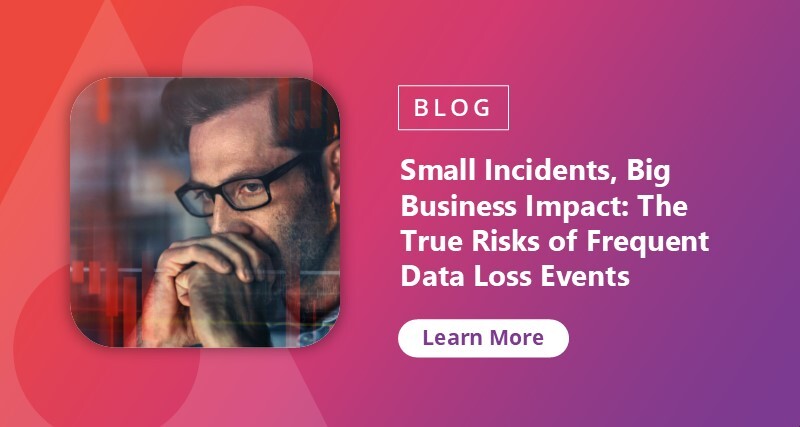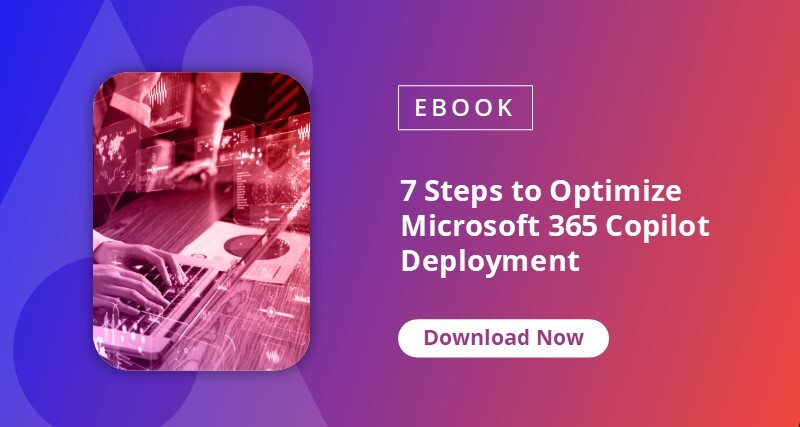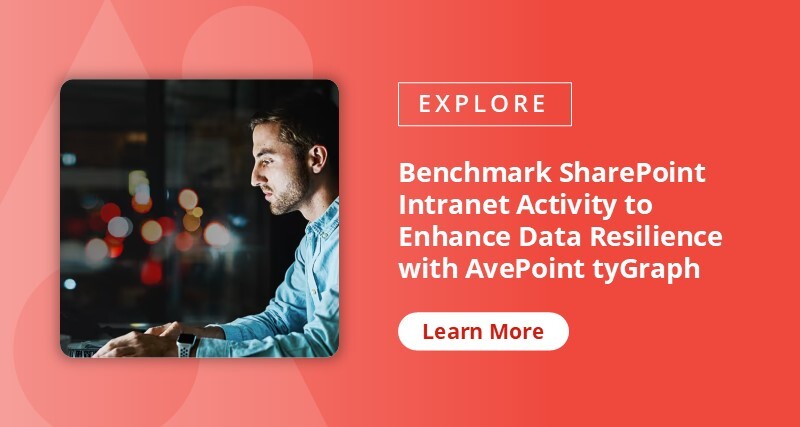The rising demand for AI adoption and the steady interest in digital transformation have inevitably made data and analytics a top priority for business leaders. However, as organizations invest in digital workplace maturity, they face the dual challenge of leveraging quality data while combating sophisticated cyberattacks. According to a Gartner survey, 61% of organizations have had to rethink their data and analytics operating model due to AI technology. In addition, Dell's Global Data Protection Index Report highlights that 97% of organizations encounter hurdles in data protection.
To future-proof growth, business leaders must ensure data resilience — the ability to withstand and recover from disruptions while maintaining data integrity. However, not all data is equally valuable. Quality data, particularly those relevant to an organization's workforce, is key to sustainable growth.
With over 250,000 organizations relying on SharePoint, including more than 85% of Fortune 500 companies, it is evident that the value of data varies across different sites. The more critical the data, the more urgent the need for its protection. Identifying and securing the most valuable data, especially the data employees engage with the most, is the first step to achieving data resilience.
This blog entry explores how organizations can benchmark intranet activity to uncover valuable data, develop strategies to protect it, and enhance data quality to boost employee engagement.

Beyond Surface-Level Employee Engagement
With developments in collaborative platforms, the rise of AI tools, and the increasing emphasis on work-life balance, many workplaces have adopted hybrid or remote setups. This shift has enabled employees to work more flexibly, improve productivity, and reduce commuting time and costs. At the same time, it has also introduced uncertainties in maintaining strong employee engagement and a cohesive corporate culture.
It is precisely during uncertain periods like this that high engagement can be pivotal in boosting employee retention. Gallup notes that teams with low engagement experience turnover rates ranging from 18% to 43% higher than teams with highly engaged members, emphasizing engagement as a crucial component for organizational growth. It's worth noting that in the previous year, employee engagement in the US fell to a 10-year record low since 2014, with only 31% of engaged employees.
To address this challenge, HR leaders and communication professionals might turn to various attention-grabbing announcements or activities in a bid to encourage engagement. However, bombarding employees with information might only create disinterest among a workforce, due to the following:
- Information overload. When employees are constantly overwhelmed with a high volume of announcements, this can lead to information overload. This overwhelming influx of data creates a roadblock for employees to discern what is truly important, leading to confusion and frustration. Instead of feeling engaged, employees may become distant as they struggle to prioritize and process excessive information.
- Lack of depth and relevance. For organizations to foster engagement, they must provide information that is directly applicable to the roles, responsibilities, and professional growth of their workforce. When disseminated information is shallow and not tailored to their specific needs, employees may perceive it as noise rather than valuable insights, leading to disengagement. Similarly, when employees have to sort through a sea of information, this can discourage meaningful knowledge sharing, as well as delay professional development for employees who may otherwise have a passion for upskilling and finding new learning opportunities.
- Eroded trust and credibility. With only superficial information to go around, employees may begin to question the authenticity and intentions behind the communication, feeling that it is more about creating a facade of engagement rather than genuinely addressing their needs and concerns. This skepticism can undermine the overall trust in leadership and the organization, further discouraging employee engagement. Instead of fostering an environment that encourages effective communication and proactive involvement, organizations may find their workforce feeling disconnected from company values and uninterested in delivering their best results. Without disseminating the right information and ensuring that this information is accessible, organizations risk creating a workplace culture stuck in a cycle of mediocre performance and disengaged individuals.
To enhance effective employee engagement, it’s a must for business leaders to provide top-notch, relevant, and actionable data that empowers employees, supports their professional growth, and aligns with their organization’s goals.
For example, organizations eager to scale AI adoption should consider creating relevant SharePoint sites on department-specific best practices to help information workers understand the productivity gains of using AI tools for their job functions.

Benchmarking Key Engagement Metrics
There is no question that organizations cannot boost employee engagement without first outlining a clear strategy. Rather, they need to take on a tactical approach to determine how and where to disseminate quality data that will encourage employee participation. Case in point, assessing analytics such as usage patterns and active sessions enables organizations to gain insights into how employees interact with digital tools like SharePoint and Teams.
Organizations can take this assessment to the next level by benchmarking three specific metrics that give them a holistic, yet in-depth perspective into the data they provide and how their employees interact with such data.
Engagement and Reach of Pages
By turning a critical eye on their engagement and page reach, organizations can learn whether specific content is targeting the right people.
In particular, business leaders can verify the quality of information that they are disseminating, and that people are finding it. They can also discern whether this content is being surfaced correctly in the first place.
Benchmarking can push these initial impressions further by revealing specific areas that need improvement and providing actionable insights. For example, roughly 30% of an organization’s workforce looking at the benefits page for their people teams could indicate that a good percentage of employees are engaged and can locate the information they need.
Even so, benchmarking this initial percentage against that of a different company may indicate that 30% is relatively low, spurring conversations on how users can better find information on employee benefits. Organizations can take advantage of these discussions by determining if relevant information has been buried under too many pages, or if employees are unclear where to locate such information.
Information Publishing
As organizations grapple with data expansion in a high-stakes digital arena, they will find that the question of quantity over quality is a crucial guidepost for ensuring that their workforce leverages the right data.
When looking into information publishing, business leaders will need to know how much information they are publishing, the frequency with which they do so, and how many users they reach every time they publish. While at first glance it might seem that going over the benchmark in publishing compared to another organization – that is, releasing numerous pieces of information more frequently than they do – might seem like an achievement, this will not automatically translate to increased and sustainable employee engagement.
By benchmarking their information publishing against other enterprises and seeing how their engagement levels match up to how much and how often information is provided to their own workforce, business leaders can pioneer a critical process for cutting down on surface-level data that offers little value to employees. More importantly, they can discern whether other business leaders are leveraging SharePoint more strategically than they are.
User Navigational Effectiveness
Ease of navigation is crucial not only for enhancing user experience on public websites but also for ensuring employees can efficiently locate information on their company intranet. As you build your organization’s SharePoint entrances, for instance, there are numerous designs and layouts available to disseminate information, making it challenging to determine if users are finding information effectively. Benchmarking user navigational effectiveness is essential for identifying areas of improvement, streamlining access to resources, and boosting overall productivity. If you have 20 to 30 file links, it is important to assess whether employees are accessing all of them equally and identify which ones are gaining the most traction.
Additionally, consider if users are navigating from the intended starting page to the desired subsequent pages. A well-structured intranet empowers employees, fostering a more connected and informed workforce.
Resilience: The New Bottom Line
As organizations continue putting a premium on collaborative workspaces and digital transformation, it’s also becoming evident that data resilience is the path forward — not just toward achieving collaborative targets and digital maturity but also safeguarding that growth against evolving cyberthreats.
To stay prepared, organizations must adopt a strategic approach to data resilience by leveraging intranet analytics to gain key insights on the quality of their data, how employees engage with and use that data, and which mission-critical data requires fortified guardrails. Monitoring high-traffic areas as well as users who access critical data also ensures that only authorized personnel have access to such data, enhancing data security and compliance. For site owners, SharePoint analytics is a significant instrument to benchmark their performance, enabling them to determine the success of pages and files in their respective sites.
At the end of the day, data resilience isn't just about protecting information — it's about creating an environment where employees can innovate, collaborate, and drive business value with complete peace of mind.

